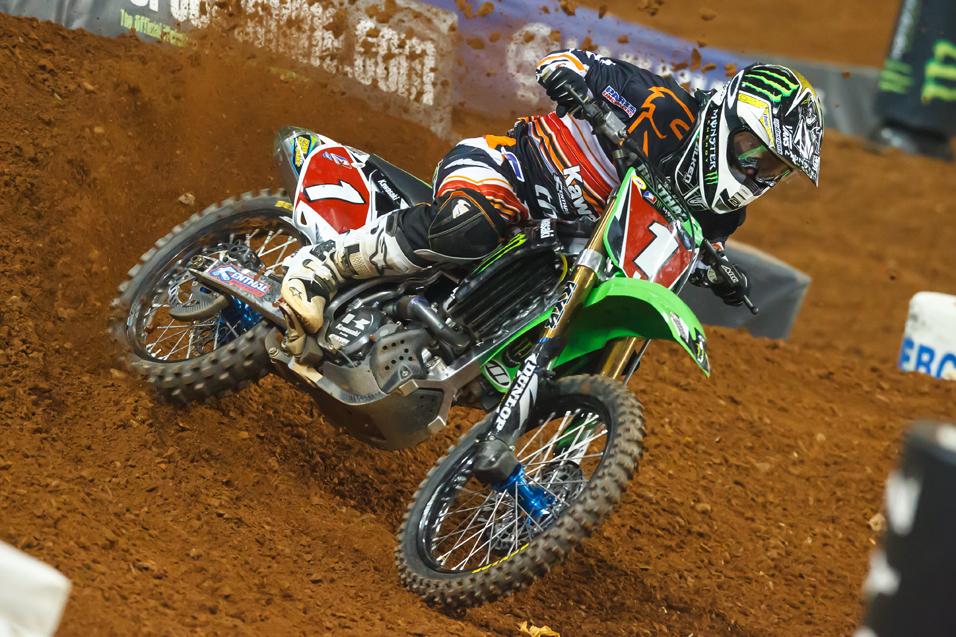By: Gary Semics
[Photos: Simon Cudby]
Ryan Dungey has a fantastic riding style and great techniques, but I believe if the trained eye looks hard enough it can usually find places to improve. At Ryan's level, his style and even his techniques are programmed into his nervous system's automatic reflex reactions so deeply from many hours of repeated practice that they fire off naturally. In order for Ryan to change a technique, he would have to overwrite the old habit by replacing it with a new one. The only way to do this is to run the new program through repetition long enough to replace the old. At first this reprogramming slows you down, and practicing a new technique can take weeks to make it happen naturally under race conditions. It's not something to do during race season.
That being said, this photo shows one of the areas Ryan could improve on. I have seen Ryan other times get his upper body out of the center of balance by rotating his shoulders toward the outside of the corner and leaning his upper body too far to the outside. He does this to correct the mistake of not leaning the bike over far enough in the first place. He then compensates by pushing the bike over farther, but doing that takes him out of the center of balance.
Sorry, Ryan, but I have another one. There are two basic positions for your back. The straight back (Strong Back) and the crouched back (Low CG Back). RD is all straight back. I have never seen him ride with a crouched back. The Strong Back is great for getting your body position up over the front of the bike, but not so good when your body position is in the middle or back a little farther. Not only should the strong back be used when in the forward body position, but also through the whoops, G-outs, and over big bumps. You have a lot more strength when your back is straight (try doing heavy barbell squats with a crouched back). Both of these back positions are used sitting and standing.

When you want more traction in a corner, it's better to have a crouched back. This lowers your bike and body's center of gravity for more traction and control in the corner. In the photo of Ryan Villopoto, you can notice he has a crouched back. He's also using a cushion berm in this corner. The combo of the low CG and cushion berm allow RV to lay the bike way over and give the big-bore all the berries. If you notice RV's back when he’s riding, you'll see he uses each back position on different parts of the track.

In the left photo of Justin Barcia you can see he has one finger on the front brake and one on the clutch. That's because he still hasn't reached the most important part of the corner: the transition, where you go from braking to accelerating. At the transition, Justin will control the throttle and let his finger off the front brake. He already has a finger on the clutch so he can deliver the exact power he wants to the rear wheel. In the right photo, Justin has gone through the transition. You can see he is off the front brake and on the throttle. He still has a finger on the clutch.
Even on four-strokes, these guys usually use the clutch and throttle together at the transition. At these points it only takes a quick nip of the clutch to get it done. Once through the transition, the finger stays on the clutch in case they want to cut the power to the rear wheel—if, for instance, the bike starts to stand up and/or climb out of a berm. Cutting the power with the clutch instead of the throttle works much more quickly and precisely. This is done with one or more quick little nips of the clutch—not disengaging it for much time at all, just enough to keep the bike down in the corner without losing much time.


There are two categories of techniques where control comes from. One is your body movements, always moving in order to maintain the center of balance. The other is comprised of the five controls of the M/C, clutch, throttle, front and rear bakes, and the gearshift. Beginner riders don't understand how much of your control comes from the five controls.
On the way into a corner I'd say about 60 percent of your control comes from the front and rear brakes and the other 40 percent from your body movements. At the transition, 60 percent control can come from a combination of the front and/or rear brake and the clutch and throttle at the same time. Sometimes braking and accelerating will overlap, meaning you're doing a little of both at the same time. They should always at least connect, meaning you go from braking straight to accelerating, never coasting. You wouldn't want to give up 60 percent of your control, would you? Once through the transition and exiting the corner, 60 percent of your control comes from the clutch and throttle and the other 40 percent from your body movements.
The right combo of the controls with the proper timing and finesse make the bike handle a certain way. To the top pros, the precise timing and finesse of these five controls are as natural and automatic as working their hands and feet. They are a part of their body and nervous system. In milliseconds, they feel what is needed, as it’s needed. That's how they make something that is so difficult look so easy.
I hope you enjoyed my first article in The Breakdown. For more riding tips, free MX Technique DVD previews, and to order online, visit www.garysemics.com.



